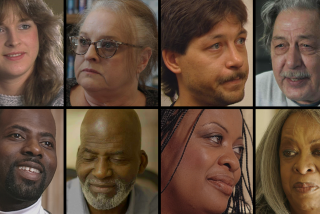White Bread, White Dread : FEAR OF FALLING The Inner Life of the Middle Class <i> by Barbara Ehrenreich (Pantheon: $18.95; 292 pp.)</i>
- Share via
The economic boom of the Reagan era was, to put it mildly, less beneficial to some groups of Americans than to others. For those who had some cash, or else owned real property, times were good; for those living more or less at the limit of their resources, not to speak of those on fixed incomes or on welfare, they were not. Indeed, many economists now estimate that while the 1980s saw a 15% rise in the assets of the most affluent, the poor grew 9% poorer during the same period. As Barbara Ehrenreich puts it in her important and controversial new book, “Fear of Falling,” “America’s income distribution is now as perilously skewed as that of India.”
Skewed income distribution is several steps of argument away from wrecked public welfare, and yet Ehrenreich is right to recognize the gravity of a situation unheard of in postwar America where most people have assumed that everyone in the country either was middle class already, or, to borrow a phrase from the unhappier quarters of modern Los Angeles, was at least a middle-class “gonnabe” or “wannabe.”
In the 1950s, as Ehrenreich demonstrates brilliantly, American writers, academics, and politicians all came perilously close to agreeing with the college newspaper editor who remarked in 1957 that “all the problems are solved. All that’s left are problems of technical adjustment.” Sociologist Daniel Bell wrote a celebrated book, “The End of Ideology,” that seemed to sum up the complacent tenor of the times, and even the usually more prescient Arthur Schlesinger Jr., asserted that the problem of poverty had been largely eliminated though there remained “enclaves where the underprivileged still can be found, as in the Southern Alleghenies or the rural Deep South.” As for class, it no longer had much relevance to an American situation in which the very poor and the very rich played only a marginal role.
Of course, not only was there a good deal of truth, however time-bound and momentary, to this analysis, but such indifference to matters of class was a time-honored American habit. From De Tocqueville forward, European visitors to the United States were amazed by its lack of what would now be called class consciousness, a cause, in the view of many, of why no political left had ever really taken hold. For their part, when serious Americans confronted what was most unjust and wicked about their society or their history, the most pressing matter seemed unarguably to be the question of race. Class conflict, particularly during the post-World War II economic boom during which the middle-class franchise seemed to be expanding steadily, was something that happened in some other part of the world.
One of the most important accomplishments of Ehrenreich’s book is the way in which she bravely (for she is not unaware of the recent worsening in race relations) and adamantly focuses her attention on class. For her, a term like middle class needs to be examined in depth, not just taken for granted, and, even for those whose political views are very different from Ehrenreich’s (she is frankly and unapologetically on the left), “Fear of Falling” should prove to be an invaluable book: lucid and provocative at the same time.
The ideas about the world that most of us have, whether in art or in politics, have emanated from the middle class, but while there has been endless prattle about life style, and endless facile evocation of yuppies, or working mothers, or professional burnout, no one in recent years has attempted to define what the American class is really all about. As Ehrenreich remarks shrewdly, “while ideas about gender, and even race, have moved, however half-heartedly, in the direction of greater tolerance and inclusivity, ideas about class remain mired in prejudice and mythology.”
“Fear of Falling” is as much a book of the late 1980s as Daniel Bell’s “The End of Ideology” or David Riesman’s “The Lonely Crowd” were books of the 1950s. In a sense, what Ehrenreich has set out to explain is how a middle class that is, on the surface at least, so astonishingly comfortable (more comfortable, one might add, than most people have been in all of recorded history) is, as she puts, so insecure and deeply anxious. The fear of falling in Ehrenreich’s title is, she claims, the essential feature of middle-class life. It is this prospect of the downward slide that, she says, provides the deep basis for the ways in which middle- class people organize their work, their family life, even their habits in recreation or food.
Ehrenreich is unfailingly humane. “Fear of Falling” is in no sense a book out to skewer the middle class or condescend to either its tastes or its anxieties. Indeed, the book is a model of sympathetic, if critical, understanding. Writers on any subject could profit from Ehrenreich’s admirable tone. At the same time, she never loses sight of her essential argument that the middle class has isolated itself from people of other social classes, almost to the point of denying their existence. This isolation, she says, benefits no one and only reinforces a status quo that makes the lives of ordinary people, including ordinary middle-class people, increasingly difficult both materially and morally.
If there is a problem with “Fear of Falling” it is, perhaps, that the only solutions that Ehrenreich offers seem based on an optimism that, given the grimness of our times, can sometimes appear more willful than realistic. Ehrenreich is, for example, almost romantic on the subject of work. “In an egalitarian future,” she says at the conclusion of “Fear of Falling,” “there would be enough work to go around, and work pleasurable enough so all would want it.” Elsewhere, while acknowledging that ours is a world of scarcity, she asserts that “there is one thing that should not be scarce, that should in fact increase, and that is good and pleasurable and decent work: the work of caring, healing, building, teaching, planning, learning.”
From someone as fiercely lucid and realistic about the world as it exists, and whose descriptions of the middle-class predicament are so unerringly right, this romanticism about human possibility comes as a letdown. The world, as I suspect she knows perfectly well, is a tragic place not only because of the deformations imposed by elites but by its very nature.
Nonetheless, “Fear of Falling” is a major accomplishment, a breath of fresh thinking about a subject that very few writers have known how to think about at all.
More to Read
Sign up for our Book Club newsletter
Get the latest news, events and more from the Los Angeles Times Book Club, and help us get L.A. reading and talking.
You may occasionally receive promotional content from the Los Angeles Times.






